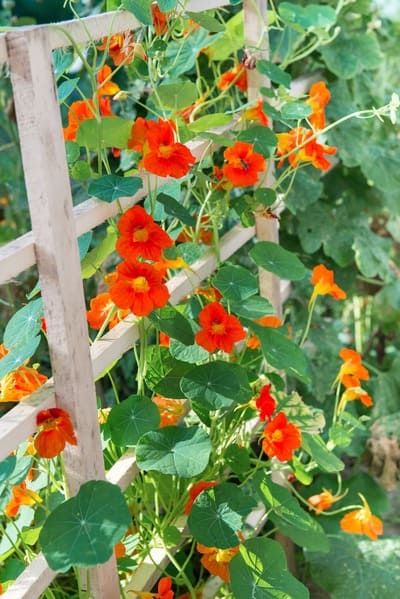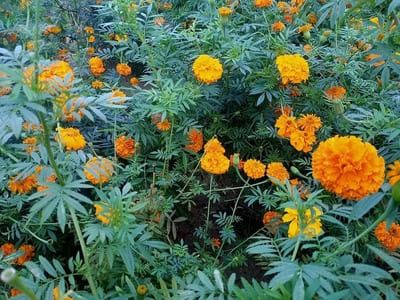Incorporating edible flowers into your landscaping not only adds vibrant colors but also enhances your garden’s functionality. These dual-purpose flowers are perfect for creating a visually stunning edible landscape that is both practical and delightful. Whether you’re a fan of gardening or culinary adventures, here are the top beautiful flowers you can eat for your garden.

Why Choose Edible Flowers for Landscaping?
Combining beauty and functionality, edible landscaping allows you to grow plants that are as pleasing to the eye as they are to the palate. These dual-purpose flowers:
- Enhance your garden’s visual appeal.
- Provide fresh, organic ingredients for your meals.
- Support pollinators like bees and butterflies.
By incorporating these best flowers for edible landscaping, you can create a vibrant, multi-functional space that reflects both your aesthetic and culinary passions.
1. Nasturtium

Nasturtiums are a favorite in edible landscaping due to their bright, cheerful flowers and peppery taste. Their trailing vines make them perfect for borders, trellises, and even container gardens.
Uses: Add flowers to salads or use the leaves in pestos.
2. Calendula

Known as “pot marigold,” Calendula is an all-star edible garden flower. Its golden blooms not only brighten up your garden but also offer a slightly tangy, peppery flavor.
Uses: Use petals as a garnish for soups, rice dishes, or herbal teas.
3. Pansies

Pansies bring charm to any garden with their vibrant, multi-colored blooms. They are delicate and flavorful, making them an ideal choice for flowers for landscaping and cooking.
Uses: Perfect for decorating cakes, cookies, and cocktails.
4. Borage

Borage produces star-shaped, blue flowers that are as delicious as they are beautiful. This herb is a must-have for any edible landscape.
Uses: Float flowers in beverages or add them to salads for a cucumber-like flavor.
5. Lavender

Lavender is an iconic flower for both aesthetic edible gardens and culinary purposes. Its soothing fragrance and delicate blooms add a touch of elegance to any setting.
Uses: Infuse flowers in desserts, syrups, or teas for a floral twist.
6. Roses

Roses are classic beautiful flowers you can eat, offering a fragrant and sweet flavor. Choose varieties grown without chemicals for safe consumption.
Uses: Use petals in desserts, jams, or beverages like rose water.
7. Marigold

Not all marigolds are edible, but the signet varieties are! Their citrusy flavor and vibrant yellow and orange blooms make them a standout in edible landscaping.
Uses: Sprinkle petals on salads or use them as a garnish for soups.
8. Chamomile

Known for its calming properties, Chamomile also serves as a delightful addition to edible garden flowers. Its daisy-like flowers are both beautiful and useful.
Uses: Brew flowers into tea or use them to flavor desserts.
9. Sunflowers

Sunflowers bring a bold, cheerful vibe to any decorative edible garden. Beyond their seeds, the petals and buds are also edible.
Uses: Steam the buds like artichokes or use petals as a garnish.
10. Daylilies

Daylilies are versatile flowers for decorative edible gardens, boasting bright, trumpet-shaped blooms that are crunchy and sweet.
Uses: Add blooms to stir-fries, salads, or stuff them with cheese for a savory treat.
Tips for Growing Edible Flowers
Cultivating edible flowers in your garden can be both rewarding and enjoyable, but it’s essential to follow a few key practices to ensure a successful and safe harvest. These beautiful edible flowers can enhance your garden’s aesthetic and culinary potential, but proper care and planning are crucial.
1. Choose Organic Varieties
When growing flowers intended for consumption, always prioritize organic varieties. Avoid plants treated with harmful chemicals or pesticides, as these can compromise their safety for use in food. Opt for seeds or plants labeled as organic or sourced from trusted nurseries. This ensures your edible flowers are fresh, healthy, and safe to eat.
2. Match Plants to Your Climate
The success of your edible garden flowers depends significantly on selecting varieties suited to your local climate. Research which flowers thrive in your region’s temperature, rainfall, and soil conditions. For example, lavender and nasturtiums prefer sunny, well-drained environments, while pansies and chamomile thrive in cooler climates. Matching flowers to your growing conditions reduces maintenance efforts and promotes lush, vibrant blooms.
3. Harvest Carefully
Timing is everything when it comes to harvesting edible flowers. The best time to pick them is early in the morning when the petals are freshest and most flavorful. During this time, flowers retain their maximum moisture and aroma. Use clean scissors or shears to avoid damaging the plant, and store the harvested blooms in a cool, shaded spot until ready to use. Proper handling ensures your beautiful edible flowers maintain their quality for culinary use.
4. Experiment in the Kitchen
One of the joys of growing edible flowers is discovering their versatility in the kitchen. From garnishing salads and desserts to infusing syrups and teas, the possibilities are endless. Start with simple recipes using popular blooms like calendula, nasturtium, or borage, and gradually explore creative pairings. Edible flowers for gardens aren’t just beautiful—they’re a delightful way to elevate your cooking and presentation skills.
By following these tips, you can cultivate a thriving edible flower garden that is not only visually stunning but also a source of fresh, organic ingredients for your meals. Whether you’re a seasoned gardener or just starting, these practices will ensure your edible landscaping is both beautiful and bountiful.